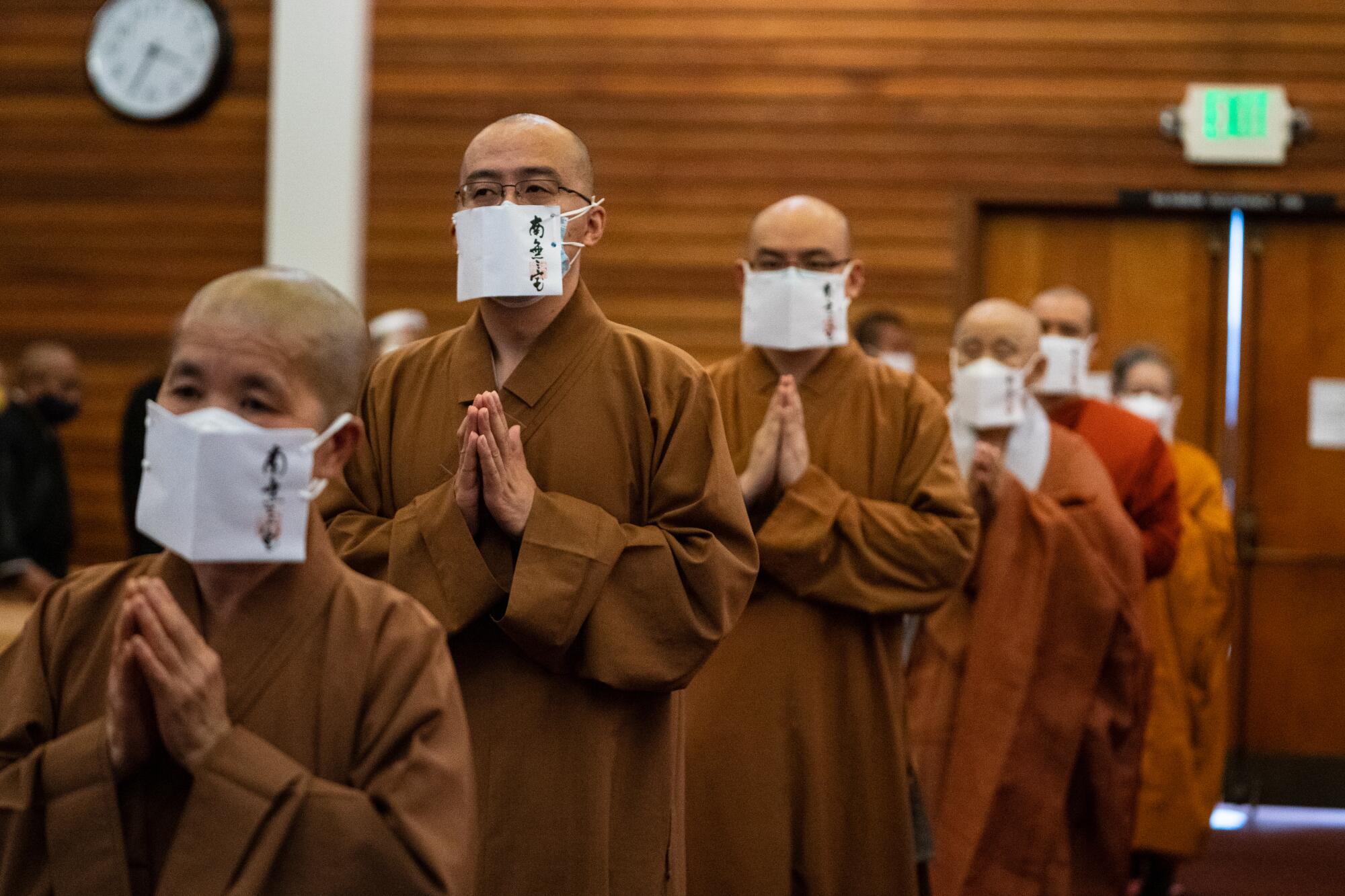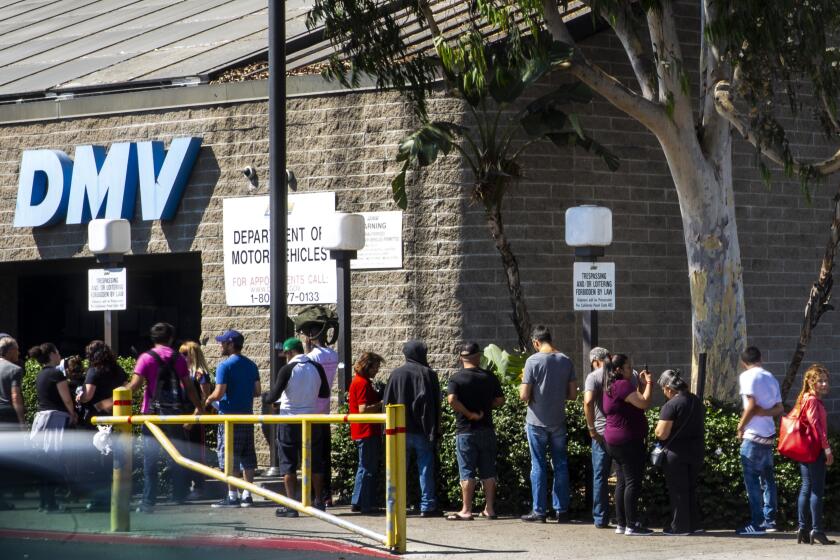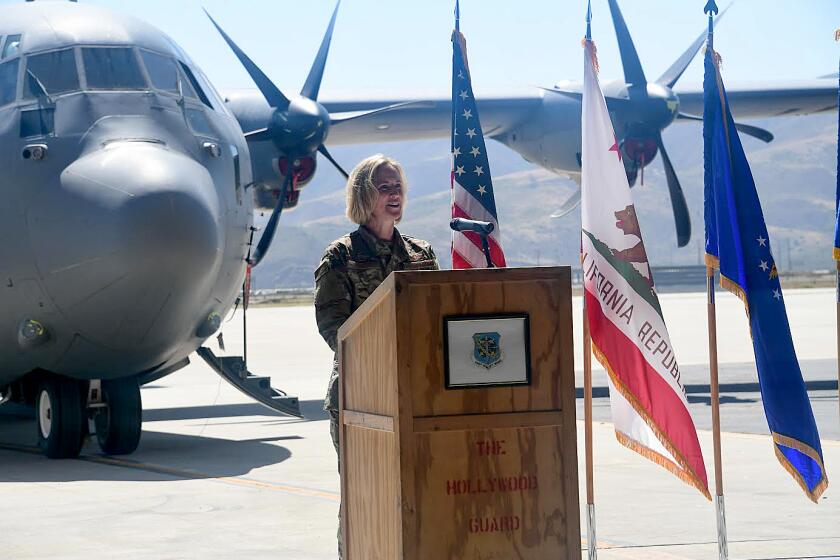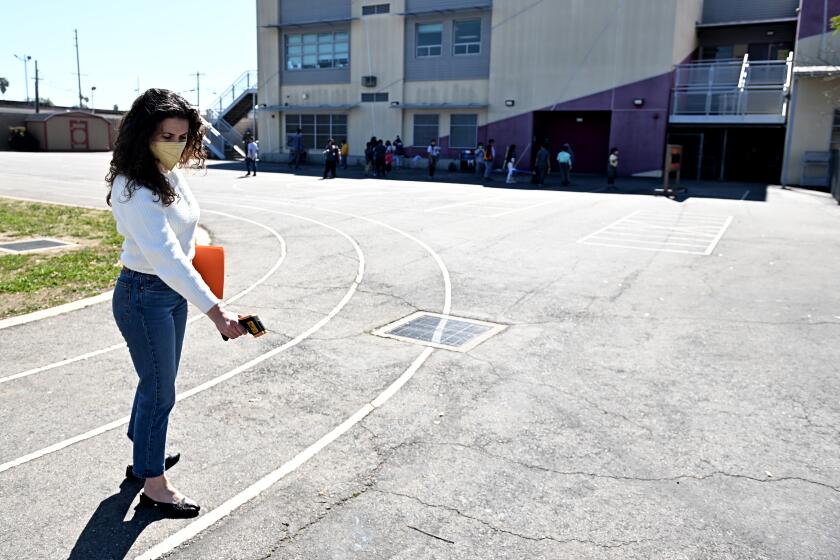
One by one, the Buddhist priests, nuns and teachers silently entered the Los Angeles temple in similar robes of black and saffron hues, with identical gestures of hands clasped in prayer.
But they represented the dazzling diversity of Buddhist traditions and Asian cultures and languages in a healing ceremony against racial hate — a cause so urgent that it recently drew together followers of every major school of Buddhism for what is believed to be the first time since the tradition was founded 2,500 years ago.
There were Japanese Americans from Little Tokyo. Chinese and Taiwanese from the San Gabriel Valley. Vietnamese from Westminster. Koreans from Los Angeles and Garden Grove; Tibetans from Long Beach; Thais from Hollywood and Yucca Valley. Cambodians came in from Santa Ana and Sri Lankans, from Mid-City. Black, Latino and white Buddhists also attended the ceremony Tuesday at the Higashi Honganji Buddhist Temple in Little Tokyo.

The diverse gathering was meant to send a powerful message of healing through an interconnected community and could have happened only in Southern California, the most religiously diverse region on the planet and only place where the world’s two dozen Buddhist lineages are represented, said Duncan Ryuken Williams, a Soto Zen Buddhist priest and chair of the USC School of Religion who spearheaded the ceremony.
“In all of these other countries in all of those hundreds of centuries, they’ve never had all of them in one place,” Williams said. “It’s only in Los Angeles where everybody is here, all of these different traditions and lineages and denominations.”
Williams, along with San Jose State University professor Funie Hsu and Bay Area Buddhist writer Chenxing Han, began brainstorming the idea for a memorial ceremony after the slayings of eight people — six of them Asian American — in Atlanta in March. That mass shooting followed a historic surge of anti-Asian hate in the last year, much of it spurred by the COVID-19 pandemic, with more than 6,600 reports of harassment, discrimination and physical assaults since March 2020.

The ceremony’s host temple, Higashi Honganji, itself was hit by vandalism and a fire in February, as were six Vietnamese Buddhist temples across Little Saigon last November.
But Williams, Hsu and Han wanted to go beyond issuing statements. Williams suggested a healing ceremony to be held on the 49th day after the Atlanta killings, timing it to the day when Buddhists believe departed souls transition to another spiritual realm.
“I was like, let’s do something that can move people’s hearts and heal people, because that’s what I feel everyone is wanting,” Williams said.
They also wanted to offer a Buddhist response to hate — not only in Atlanta but also throughout centuries of American history.
In the ceremony’s opening remarks, Hsu and Han acknowledged that the Little Tokyo temple was built on Tongva territory, which was stolen from the Indigenous people during centuries of violent colonialism. They recalled brutal racism against Chinese immigrants in the 19th century, the forced incarceration of Japanese Americans during World War II, the discrimination against South and Southeast Asians in the 1970s as they fled wars inflamed by the U.S. military.
“We want to acknowledge that it’s quite natural to have feelings of anger, of wanting to kind of fight back,” against such hate, Williams said. But Buddhism calls for a different — and opposite — path in order to truly repair and heal.
“When there is ignorance, we need wisdom. When there is greed, we need generosity. And when there is hatred, we need lovingkindness,” he said.
Larry Ward, a Black dharma teacher with the Lotus Institute trained under the lineage of famed Vietnamese Zen master Thich Nhat Hanh, decried the “despicable attacks of physical and cultural habits of toxic brutality, disrespect and emotional injury” against people of color for centuries. Although responding with legal actions and “social and structural accountability” are important, he said, deeper ties among people across race, language and national boundaries were the best hope for change.
“If enough of us are able to recover and touch that wellspring of kinship,” he said, “we may realize a breakthrough that we’re all praying for.”
Those messages were punctuated by rituals of rich symbolism during the 90-minute ceremony, which was livestreamed to thousands of members of more than 350 Buddhist communities in the nation and as far away as Germany. They organized watch parties, parallel ceremonies and follow-up Zoom discussions.
Six memorial tablets bearing the names of victims of hate, and a seventh dedicated to “all beings who have lost their lives through racial and religious animus” were placed at the front of the sanctuary as the Buddhist priests, monks and teachers laid down lighted candles and offered incense before them.

Another ceremonial object was a ceramic lotus flower, handcrafted for the occasion with cracks deliberately inserted into its leaves. The lotus flower, which rises clean from muddy roots, symbolizes purity and enlightenment in many Eastern traditions. Several Buddhist priests ritualistically covered the cracks with gold lacquer, a Japanese art known as kintsugi, to symbolize the work of repairing the world.
And as the ceremony drew to a close, the Buddhists passed a long white string among themselves and held it over their shoulders as they processed out of the sanctuary. They entered individually but were now leaving interconnected.
“We do not suffer alone, nor do we heal alone,” Hsu said. “Only when we join together...can we truly support each other’s freedom.”
More to Read
Start your day right
Sign up for Essential California for news, features and recommendations from the L.A. Times and beyond in your inbox six days a week.
You may occasionally receive promotional content from the Los Angeles Times.







